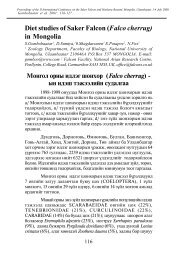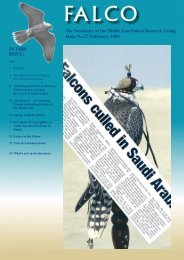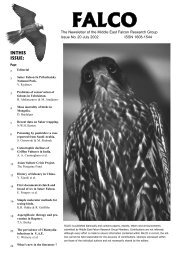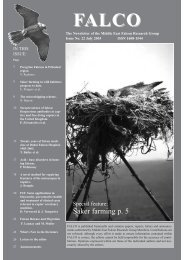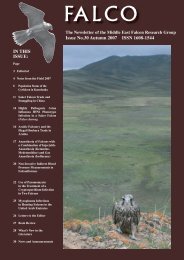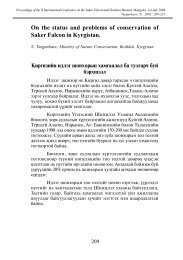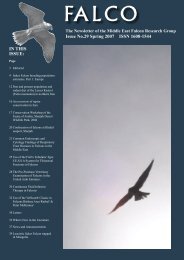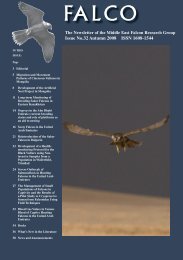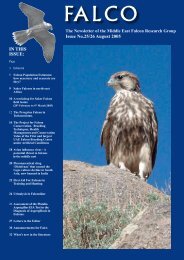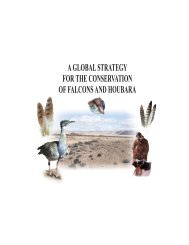Falco cherrug - International Wildlife Consultants Ltd.
Falco cherrug - International Wildlife Consultants Ltd.
Falco cherrug - International Wildlife Consultants Ltd.
Create successful ePaper yourself
Turn your PDF publications into a flip-book with our unique Google optimized e-Paper software.
of Zoology and Ecology, Chinese Academy of Sciences,<br />
Urumqi and from the Museum of the Quinhai-Tibetan<br />
Plateau, Xinin. We also thank Mr. Barturkhan of the Urumqi<br />
Institute of Zoology and Ecology for his help in the field<br />
and for his enthusiasm.<br />
References<br />
Xiaodi, Y. and Fox, N. 2003. China 2002. <strong>Falco</strong> 21: 7-8.<br />
Lai, Chen Hsun and A. T. Smith. 2003. Keystone status of<br />
plateau pikas (Ochotona curzoniae): effect of control<br />
on biodiversity of native birds. Biodiversity<br />
and Conservation 12: 1901–1912, 2003.<br />
Ming, Ma, Potapov, E. and Xiaodi, Y. 2003. Breeding biology<br />
of Barbary <strong>Falco</strong>n <strong>Falco</strong> pelegrinoides in<br />
Xingjang. Sichuan Jourlan of Zoology 22 (2): 16-<br />
17.<br />
Schaller G.B. 1998. <strong>Wildlife</strong> of the Tibetan Steppe.<br />
University of Chicago Press, Chicago, Illinois.<br />
Illegal trapping of falcons still continues in the Baikal region.<br />
V.V. Ryabtsev<br />
Pribaikalsky National Park, Irkutsk, Russia<br />
Russian conservation legislation and its enforcement<br />
is still not a sufficiently serious barrier to prevent illegal<br />
trapping of raptors. We hoped that the “Law on<br />
Protected Species” (see <strong>Falco</strong> 21) which was adapted in<br />
UAE might somewhat affect the illegal trapping in the area.<br />
However, despite the positive news, there is no decrease in<br />
cases involving Syrian trappers. The problem caused by<br />
these trappers has already been addressed (Ryabtsev 2001,<br />
<strong>Falco</strong> 20, 21).<br />
On 11 September 2003 I found a dead Saker in the<br />
Pribaykaskiy National Park. Its feet were entrapped in nooses<br />
of the ‘pigeon jacket’. It had been dead for at least 2<br />
weeks. A local herdsmen told me that from August onwards<br />
he regularly sees a dark Niva” 4WD exploring the steppe.<br />
We also saw this car, but failed to catch it. On 21 September<br />
in the same region we found a pigeon with ‘jacket’ – i.e.<br />
with a frame fitted with nooses. The pigeon was flying well,<br />
and it was not possible to catch it. In order to prevent possible<br />
death of raptors we had to shoot the pigeon. Some time<br />
later we found the dark “Niva” 4WD and searched it under<br />
our license. There were two Syrian trappers in the car, at<br />
least 20 ‘pigeon jackets’, 12 pigeons, hoods, strings, and<br />
Left: Pigeon with nooses. Right: dead Saker entangled in<br />
pigeon noose trap.<br />
special sacks to pack falcons. Both men in the car were<br />
booked at the local Militia (Police) station.<br />
In the autumn of 2003 I rarely visited the steppe area<br />
of the Pribaykalskiy National Park, but nevertheless I saw<br />
signs of illegal trapping in almost every trip. During one trip<br />
we found another ‘pigeon jacket’, already being used.<br />
Frequently we saw a pigeons with nooses on in the flocks of<br />
pigeons, that usually live at every herdsman camp.<br />
It looks as if the illegal trapping, which by 2000<br />
caused the 10-fold decline in the Baikal Saker population,<br />
still continues. In October-December in the National<br />
Park wintering gyrfalcons also get trapped.<br />
Nesting conservatism in Peregrines at the Pechora Delta.<br />
Glotov A.S., “Nenetskiy” State Nature Reserve.<br />
The “Nenestkiy” State Nature Reserve has carried<br />
out a Peregrine <strong>Falco</strong>n monitoring programme since 1996.<br />
The search for nests has been done using a motorboat along<br />
rivers in the beginning of July, mostly at night when the<br />
majority of birds sit on their nests. In 1996 we surveyed 287<br />
km of river banks within the reserve. In total we have found<br />
6 Peregrine nests. The average inter-nest distance ranged<br />
from 15 to 18 km. The shortest distance between a nest and<br />
a settlement was 20-25 km. All recorded nests were located<br />
on river bends, on precipices from 7 - 22 m high, and some<br />
30 to 60 cm below the upper edge of the precipices. All<br />
were scrapes within tussocks. Clutch size varied from 2-3<br />
eggs. All nest-sites found in 1996 were re-visited in 2003<br />
and were confirmed as active. In 1998 there were two additional<br />
pairs of Peregrines found within the same area, one of<br />
which was breeding. By 1999 both new pairs were breeding.<br />
In 2000 we found an additional 2 pairs and one single<br />
individual.<br />
Between 1999-2000 only one of the 6 traditional<br />
pairs disappeared, and in 2001 that site was reoccupied.<br />
The data from Peregrine Monitoring in the<br />
12<br />
10<br />
8<br />
6<br />
4<br />
2<br />
Pairs<br />
Cltuch size<br />
0<br />
1994 1996 1998 2000 2002<br />
Figure 1. Numbers and clutch size trends.<br />
Nenetskiy Nature Reserve shows once again that the peregrine<br />
nest sites are as conservative as they are elsewhere in<br />
the range. Numbers in the past years certainly show an<br />
increasing trend, and the average clutch size demonstrated a<br />
more or less stable trend with overall average 2.8 eggs per<br />
clutch (N=45).<br />
12



